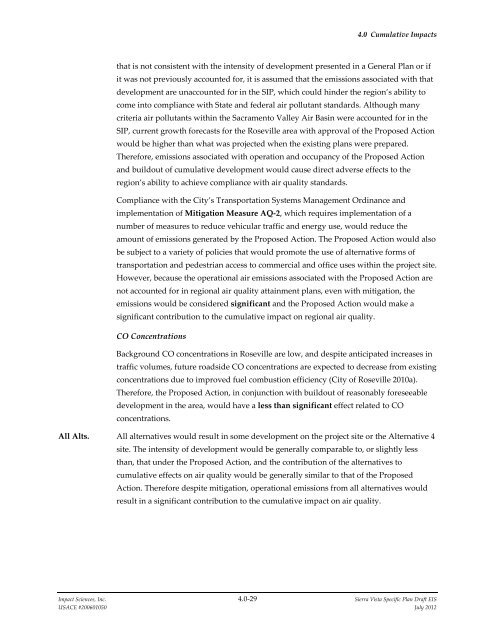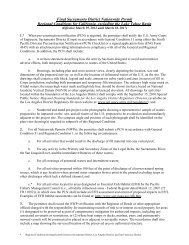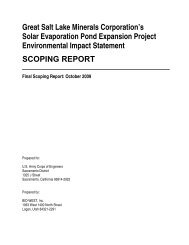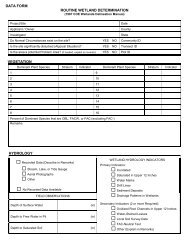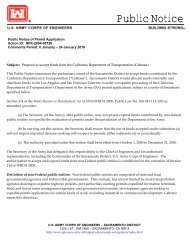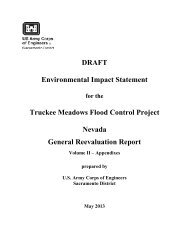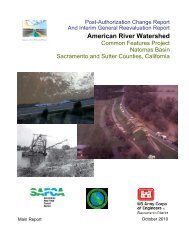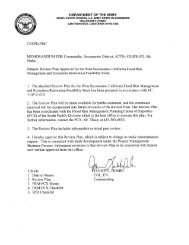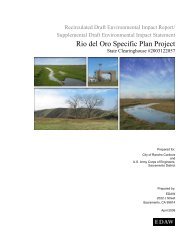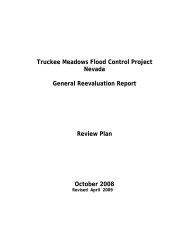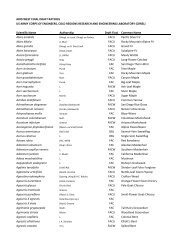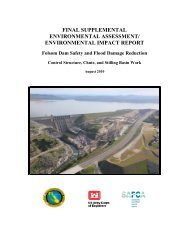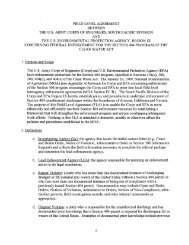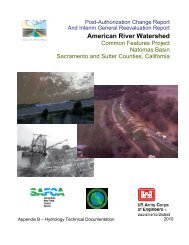4.0 CUMULATIVE IMPACTS - Sacramento District - U.S. Army
4.0 CUMULATIVE IMPACTS - Sacramento District - U.S. Army
4.0 CUMULATIVE IMPACTS - Sacramento District - U.S. Army
You also want an ePaper? Increase the reach of your titles
YUMPU automatically turns print PDFs into web optimized ePapers that Google loves.
<strong>4.0</strong> Cumulative Impacts<br />
that is not consistent with the intensity of development presented in a General Plan or if<br />
it was not previously accounted for, it is assumed that the emissions associated with that<br />
development are unaccounted for in the SIP, which could hinder the region’s ability to<br />
come into compliance with State and federal air pollutant standards. Although many<br />
criteria air pollutants within the <strong>Sacramento</strong> Valley Air Basin were accounted for in the<br />
SIP, current growth forecasts for the Roseville area with approval of the Proposed Action<br />
would be higher than what was projected when the existing plans were prepared.<br />
Therefore, emissions associated with operation and occupancy of the Proposed Action<br />
and buildout of cumulative development would cause direct adverse effects to the<br />
region’s ability to achieve compliance with air quality standards.<br />
Compliance with the City’s Transportation Systems Management Ordinance and<br />
implementation of Mitigation Measure AQ-2, which requires implementation of a<br />
number of measures to reduce vehicular traffic and energy use, would reduce the<br />
amount of emissions generated by the Proposed Action. The Proposed Action would also<br />
be subject to a variety of policies that would promote the use of alternative forms of<br />
transportation and pedestrian access to commercial and office uses within the project site.<br />
However, because the operational air emissions associated with the Proposed Action are<br />
not accounted for in regional air quality attainment plans, even with mitigation, the<br />
emissions would be considered significant and the Proposed Action would make a<br />
significant contribution to the cumulative impact on regional air quality.<br />
CO Concentrations<br />
Background CO concentrations in Roseville are low, and despite anticipated increases in<br />
traffic volumes, future roadside CO concentrations are expected to decrease from existing<br />
concentrations due to improved fuel combustion efficiency (City of Roseville 2010a).<br />
Therefore, the Proposed Action, in conjunction with buildout of reasonably foreseeable<br />
development in the area, would have a less than significant effect related to CO<br />
concentrations.<br />
All Alts. All alternatives would result in some development on the project site or the Alternative 4<br />
site. The intensity of development would be generally comparable to, or slightly less<br />
than, that under the Proposed Action, and the contribution of the alternatives to<br />
cumulative effects on air quality would be generally similar to that of the Proposed<br />
Action. Therefore despite mitigation, operational emissions from all alternatives would<br />
result in a significant contribution to the cumulative impact on air quality.<br />
Impact Sciences, Inc. <strong>4.0</strong>-29 Sierra Vista Specific Plan Draft EIS<br />
USACE #200601050 July 2012


